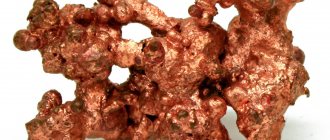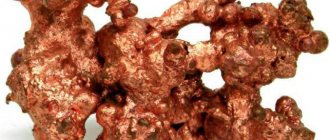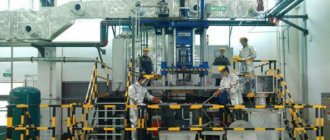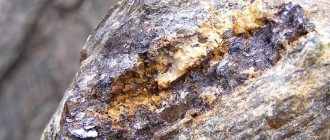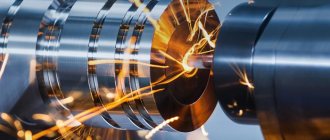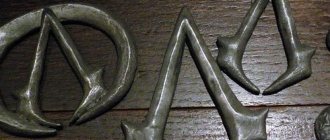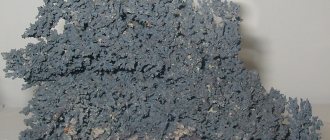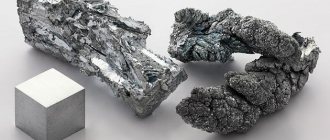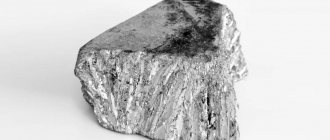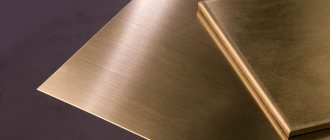Physico-chemical properties of copper
In its natural environment (in air), copper has a bright yellow-red hue. This color is given to the metal by the oxide film that forms on its surface. Pure metal is a fairly soft material; it can be easily rolled and drawn. But the use of certain impurities in its production makes it possible to increase its hardness and change other parameters.
The density of this material is 8890 kg/m3, the melting point is within 1100 °C.
The key property that determined its applicability in everyday life and production. In addition to high electrical conductivity, copper is characterized by high thermal conductivity. The use of impurities such as iron, tin and some others have a significant impact on its properties.
In addition to the above parameters, copper has a high melting and boiling point. Copper is highly resistant to corrosion.
Copper in nature
The physical parameters of copper make it possible to obtain various products from it, for example, wire several microns thick.
Copper and its compounds have found their application, first of all, in the electrical industry, although any other area of industry is unlikely to survive without it.
Application area
Of course, the use of bronze does not lose its popularity in our time. Souvenir products, decorative interior items, decorations for gates and gates... In addition, the alloy is used for the manufacture of fittings (handles, hinges, locks) and plumbing fixtures (taps, fittings, gaskets, faucets). Bronze also has wide range of uses in industrial applications. Thus, cast alloy is used for the manufacture of bearings, sealing rings, and bushings.
The widespread use of bronze is particularly influenced by its corrosion properties. For this reason, it is used to make parts of mechanisms that operate in constant contact with water. The high elasticity of the alloy makes it possible to make springs and parts of control and measuring equipment from it.
Copper and its alloys as a source of non-ferrous secondary metal
In practice, there are two types of alloys - brass and bronze. Meanwhile, they can be divided into several more groups.
Bronze with a high aluminum content. It is used for the manufacture of parts that operate under high temperatures and in aggressive environments, such as sea water.
Lead bronze is a material with high anti-friction properties, and it is widely used in industry.
Mining non-ferrous metals is an expensive enterprise and therefore many parts and components are made from recycled metal.
That is, there are many collection points for recycled materials. They specialize in recycling copper alloy scrap and transferring it to non-ferrous metal factories. This approach ultimately makes it possible to replace many products for the manufacture of which mined copper and compounds obtained from it are used.
Sources of copper for recycling
Saving resources is an important environmental and technological task. Copper is too valuable an element to be thrown away easily. Therefore, when disposing of household devices and appliances (TVs, refrigerators, computer equipment), you need to cut off all copper-containing elements and take them to recycling collection points. Factories must organize a centralized collection of decommissioned power cables and transformers, electric motors, and other copper-containing parts and devices. There is a certain copper content in spoiled fluorescent lamps, which should also be taken into account when recycling.
Copper and copper alloys, mastered by mankind at the very dawn of civilization, remain popular materials in the technological era, the basis of which is iron. Modern industrial production cannot be imagined without the use of non-ferrous metals. In the future, the need for copper and its alloys will only grow, so it is very important to treat these materials sparingly and use them rationally.
Rate this article:
Rating: 0/5 — 0 votes
Brass
When zinc is added to the copper melt, an alloy called brass is obtained. There is two-component brass, it contains only copper and zinc. In addition to it, the industry produces special alloys, which contain numerous alloying elements.
The use of zinc as an alloy component significantly increases the strength parameters of copper. Brass, which contains about 40% zinc, reaches maximum ductility.
Most of the brass produced is used for the production of rolled products - pipes, sheets, wire and many others.
Brass
When marking brass, a set of letters and numbers is used. The letter L indicates that it is brass. This is followed by a set of symbols showing what materials are included in this alloy. It should be noted that the zinc content is not shown. In order to recognize it, it is necessary to subtract from 100% the amount of base material and other elements included in the copper alloy. For example, L90 brass contains 90% copper, and the rest is zinc.
If we compare the characteristics of brass and copper, it should be noted that brass has higher strength parameters and is resistant to corrosion.
According to their technological purpose, they are divided into foundry and those processed under pressure. The latter are called deformable.
Key Facts
Copper is a very important material for humans. The first tools that people used were copper products. Previously, metal processing was carried out using the cold method, which is confirmed by various archaeological finds in North America. Even before the arrival of Columbus, the Indians preserved such traditions. It has been established that 7,000 years ago people mined and used copper ore. It is thanks to its pliability that it has become very popular.
Copper has a reddish tint due to the small amount of oxygen in the composition. If this element is completely excluded, the tint will be yellowish. If you polish copper, it will have a bright shine. The higher the valence, the weaker the shade. For example, copper carbonates are usually green or blue in color.
After silver, copper is the second metal that has good electrical conductivity. Because of this, it is actively used in electronics. Copper reacts poorly to oxygen. It becomes covered with a film due to oxidation in the fresh air.
Copper oxide can be obtained by calcining copper, bicarbonate or nitrate in air. This compound is capable of having an oxidizing effect on organic compounds.
If you dissolve copper in sulfuric acid, copper sulfate comes out. It is used in the chemical industry and is also used as a preventative against crop pests.
Depending on the influence of impurities on the character of the overall copper alloy, 3 main groups can be distinguished.
- The first includes those compounds that, together with copper, create solids. This applies to arsenic and antimony. This also includes iron, zinc, nickel, tin, aluminum, phosphorus and others.
- The second group consists of compounds that are practically insoluble in copper. An example is bismuth, lead and others. Because of them, treatment by pressure is difficult. This has virtually no effect on electrical conductivity.
- The third group is sulfur and oxygen. Together with copper, they create chemical compounds that are distinguished by their fragility.
Bronze
This is the name given to the alloy of copper and tin. In addition to the latter, bronze can contain aluminum, silicon, lead and many other substances. Alloys of this type can be divided into those processed by injection and casting.
The marking of this copper alloy is as follows - Br, denotes bronze, then there are alphanumeric designations showing the content of other elements of the mixture.
Bronze
Manufacturers produce tin bronzes, that is, made with a high tin content. And those that were obtained without his participation. An alloy of copper and tin can be used in the production of liners for plain bearings.
Popular copper alloys
Phosphorus, gold, zinc and manganese are usually used as alloying components in copper alloys. Their concentration is usually less than 10%. The only exception is brass. This proportion depends on what properties of the alloy are required, and also takes into account its purpose.
Here are the main types of copper alloys:
- Mixture with tin. It is considered one of the very first to be discovered. Even in Ancient Greece, it was actively used to create masterpieces, which are currently valuable to people. Today, the process of creating such an alloy has been significantly improved. Arc-type furnaces are used electrically. A vacuum is used to protect against oxidation. The alloy is hardened to increase its strength and ductility.
- Aluminum bronze. This alloy of copper and aluminum can become deformed. Virtually no corrosion. It is usually used to create parts that will be exposed to high temperatures.
- A mixture of copper and lead. This material has anti-friction properties. Due to the addition of lead, the strength indicator is significantly increased.
- Brass. This is an alloy of 2 or 3 components.
- Nickel silver is a copper-based alloy, with nickel added - from about 6 to 34%. Zinc is also included in the composition. The cost of such material is less than that of cupronickel, but in terms of external data, characteristics and properties they are identical.
- A mixture of copper and iron. This is possible due to the fact that both materials have similar chemical properties, but at the same time they have different melting points, so the result is a porous alloy.
Copper alloys are used in many industries
Copper-based alloys are used in industry. It is difficult to find at least one industry where copper is not used for the production of various parts. In its pure form, the metal is used in electrical communications. Heat exchange chambers, pipelines, and vacuum mechanisms consist of 1/3 of this metal.
Alloys are actively used in the production of automobiles and agricultural equipment. Due to their high resistance to corrosion, copper alloys are used for the production of equipment in the chemical industry. A mixture of lead and copper is used to create superconducting technology.
When you need to make parts with a complex pattern, you need an alloy that has ductility and toughness. Soft copper meets these criteria. You can make any cords and parts from it. The wire bends well. In addition, it can be connected (soldered) to silver and gold surfaces. Copper alloys interact well with enamel. This surface will last a long time, it will not peel off or crack.
Bronze as a copper alloy
Bronze as a copper alloy is actively used in human life
Copper and its alloys are very diverse. One striking example is bronze. This is a mixture of copper, silicon, aluminum, beryllium and other elements (the only exception is zinc). The brand consists of the symbol Br and other letters that indicate the alloying substance. Then a number is written that indicates their proportions. For example, brand BrOTsS4-4-2.5. This set of symbols means that bronze contains 4% tin, the same amount of zinc and 2.5% lead. Everything else is copper.
There is a classification based on the content of additional substances in the general alloy. There are tin and tin-free bronze types. The latter has subspecies. Bronze characteristics:
- Tin. This mixture with tin has a high corrosion resistance and also has an anti-friction effect. Due to this, the material is often used in the chemical industry. This is usually a mixture with nickel. Phosphorus and zinc can also be added. The latter material is added no more than 10%. Thanks to this, the alloy is inexpensive, but its characteristics do not change. Thanks to the last two elements, the anti-friction effect is improved. BrOts4–5 are used in the production of springs. This applies to wrought bronzes. Regarding casting bronzes, they are usually used for fittings and antifriction products. For example, these are BrO4Ts4S17, BrO5TsNS5, BrO3Ts12S5.
- Aluminum. It has good corrosion resistance in salt water and tropical climates. If the bronze is 1-phase, then it has good flexibility and is used for deep stamping. If the bronze is 2-phase, then it is subjected to hot deformation or used for shaped casting. In terms of casting characteristics, aluminum bronze is inferior to tin bronze, but thanks to it, more dense products are obtained. Examples of aluminum bronze are BrAZHN10-4-4, BrA10Zh3Mts2.
- Siliceous. By adding silicon (no more than 3.5%), the material becomes stronger and more elastic. Due to nickel and manganese, corrosion and mechanical properties are improved. This bronze is easy to process by cutting, pressing and welding. Due to their elasticity, mechanical characteristics and resistance to corrosion, silicon bronzes are used to create spring-loaded products for various devices, including radio equipment. Moreover, the parts are installed in equipment that will operate in aggressive conditions - sea water, temperatures up to 2,500°C. An example of silicon bronze is BrKMts3–1.
- Beryllium. These alloys are distinguished by the fact that they are strengthened by heat treatment. They have high tensile strength, good yield strength, and elasticity. It is resistant to corrosion. Can be cut and welded. They are actively used to create springs, membranes and other parts that will work for wear. The elements are usually used for electronic devices. An example of beryllium bronze is BrB2.
- Lead. Lead is almost insoluble in liquid copper. After the alloy hardens, it will consist of individual crystals of copper and lead. Thanks to this unusual structure, there are anti-friction properties. Because of this, such alloys are used to create bearings and liners that will operate at high speeds and pressures. The thermal conductivity of BrS30 bronze is 4 times greater than that of tin alloys. Thanks to this, it effectively removes heat that occurs due to strong friction. Quite often, tin and nickel are added to lead alloys to improve corrosion and mechanical properties.
All these types of bronze are actively used in industry and other sectors.
Attention: brass
Brass is understood as a mixture of copper and zinc, with the latter component ranging from 5 to 44%. If the composition also includes zinc (from 5 to 20%), then such brass is called red or tombac. If the zinc content is from 20 to 35%, then the brass is called yellow. Brass, where the zinc concentration is more than 45%, is rarely used in practice.
The classification of brass is as follows:
- Two-component. It is also called simple. Only copper, zinc and a small amount of impurities are included.
- Multicomponent - special. In addition to zinc and copper, other alloying components are included in the composition.
The grade of brass is designated as the letter L and a two-digit number that indicates the proportion of copper. For example, if the brass grade is L80, then the copper content is 80% and zinc – 20%.
Tompak can be designated as L96. Then the copper content is approximately 95-96%. Tompak can also be designated as L90. In this case, honey contains approximately 88–91%. In both cases, no more than 0.2% impurities are allowed.
The semi-tompak is designated as L85. This means that it will contain from 84 to 86% copper. If semi-tompak is written as L80, then the copper content will be from 79 to 81%. In both cases, the allowed impurity content is no more than 0.3%.
Brass is also designated as L70. In this case, copper will be approximately 69–72%, impurities are allowed no more than 0.2%. If the brand is L68, then the concentration of the main substance is from 67 to 70%, and no more than 0.3% of impurities are allowed. Brand L63 assumes that the copper content will be from 62 to 65%, and impurities can be up to 0.5%. If the brand L69 is written down, then the main component will be from 59 to 62%, with impurities - no more than 1%.
2-piece type brass is fairly easy to pressurize. Typically, products are made from it in the form of pipes, sheets, and other things. Brass parts can crack due to high internal stress. When they are stored outdoors for a long time, cracks appear, which can be located both in width and length. To prevent this, you need to use low temperature exposure (temperature 200–300°C).
But there are much more brands of polycomponent brass than 2-component brass. In the designation, L is written first. Then letters are written indicating the alloying components that are included in the composition of the substance in addition to zinc. After this there is a hyphen and the numbers are written. The first digit indicates the concentration of the main substance (in percent). All the rest are the proportions of alloying substances. Their sequence will be the same as in the part with letter designations. Those elements whose proportion is larger are written first. For example, if the brand is written as LAZHMts66-6-3-2, then this means that it contains 66% copper, 6% aluminum, 3% iron and 2% manganese.
For information
The main alloying substances in multi-component brass are as follows:
- Manganese. It is used to improve the strength of the finished product. Increases resistance to corrosion. This is especially true when combined with iron. This is also suitable for tin and aluminum.
- Tin. Also used to improve strength. The final substance will also be highly resistant to corrosion, especially in salt water. Such materials that have tin inclusions are often called marine.
- Nickel. This substance also improves strength and adds corrosion resistance in a variety of conditions.
- Lead. Because of it, the mechanical characteristics deteriorate, but at the same time the ability to be processed by cutting improves. Usually they add a little - the content in brass is no more than 1-2%. This is used for parts that will be machined. That is why such brass is also called automatic brass.
- Silicon. Because of this, the hardness of the material deteriorates, as does the strength. But if you add both silicon and lead at once, the antifriction properties increase. Such brass can replace bronze, which is used in bearings and is considered more expensive in price.
Brass is one of the popular metals used in industry
Marking according to GOST
Copper alloys are divided according to their technical characteristics:
- foundries;
- deformable;
- thermally hardened;
- thermally non-hardening.
Download GOST 3297-2013
Brass is designated by the letter L, bronze - Br. This is followed by letters that indicate the presence of other chemicals. For example, Mts - indicates the presence of manganese, C - lead, etc. The numbers that follow indicate the percentage of impurities in the alloy.
Magnesium and its alloys
Magnesium is a non-ferrous metal that has a silvery tint and is represented by the symbol Mg in the periodic table.
Important properties of magnesium:
- Melting point - 650°C.
- Density - 1.74 g/cm3.
- Hardness - 30-40 HB.
- Relative elongation - 6-17%.
- Tensile strength - 100-190 MPa.
The metal has high chemical activity and is not resistant to corrosion in atmospheric conditions. It cuts well, absorbs shock loads and dampens vibrations. Since magnesium has low mechanical properties, it is practically not used for structural purposes, but is used in pyrotechnics, the chemical industry and metallurgy. It often acts as a reducing agent, alloying element and deoxidizing agent in the manufacture of alloys.
When marking, the letters Mg are used with numbers that indicate the percentage of magnesium. For example, the Mg96 brand contains 99.96% magnesium, and Mg90 contains 99.9%.
Magnesium-based alloys are characterized by high specific strength (tensile strength - up to 400 MPa). They are well cut, ground, polished, forged, pressed, rolled. The disadvantages of magnesium alloys are low corrosion resistance, poor casting properties, and a tendency to ignite during manufacturing.
Wrought magnesium alloys
The most common are three groups of magnesium-based alloys.
Magnesium alloys alloyed with manganese
They contain up to 2.5% manganese and are not hardened by heat treatment. They have good corrosion resistance. Since these alloys are easy to weld, they are used for welded parts of simple configurations, as well as for fittings, oil and gasoline systems that do not experience heavy loads. Among this group are the MA1 and MA8 alloys.
Alloys of the Mg-Al-Zn-Mn system
The composition of these alloys, in addition to magnesium and manganese, includes aluminum and zinc. They significantly increase strength and ductility, making the alloys suitable for the manufacture of stamped and forged parts of complex shapes. This group includes brands MA2-1 and MA5.
Alloys of the Mg-Zn system
Alloys based on magnesium and zinc are additionally alloyed with cadmium, zirconium and rare earth metals. These are high-strength magnesium alloys that are used for parts subject to high loads (in airplanes, cars, machine tools, etc.). This group includes alloys of the MA14, MA15, MA19 grades.
Casting magnesium alloys
The most common group of cast magnesium alloys belongs to the Mg-Al-Zn system. These alloys practically do not absorb thermal neutrons, therefore they are widely used in nuclear technology. They are also used to make parts for airplanes, rockets, and cars (cabin doors, instrument housings, fuel tanks, etc.). Alloys of magnesium, zinc and aluminum are used in instrument making and in the manufacture of housings for electronic equipment. This group includes brands ML5 and ML6.
High-strength cast magnesium alloys have better mechanical and technological properties. They are used in aviation for the manufacture of loaded parts. This group includes alloys ML12 (magnesium, zinc and zirconium), ML8 (magnesium, zinc, zirconium and cadmium), ML9 (magnesium, zirconium, neodymium), ML10 (magnesium, zinc, zirconium, neodymium).
Argon arc welding
Welding occurs using an electric arc in argon, i.e. in an inert environment, using consumable or non-consumable electrodes. A tungsten electrode is most often used as a non-consumable electrode. The additive is supplied to the arc zone from the outside and is not connected to the electrical circuit. Tig welding is usually used to join small products.
The quality of the welded joint depends on the degree of penetration of the steel and will be more acceptable with as little steel as possible in the resulting weld. This is achieved by correctly adjusting the heating and controlling the melting of both metals: the high temperature of the arc is concentrated on the copper, and the steel is heated and melted thanks to the thermal energy coming from the resulting weld pool.
Taking this feature into account for welding copper with thick iron, preheating is not performed. In this case, it is better to perform welding using flux. To prevent the leakage of liquid metal, with this approach, appropriate limiters are used on the copper side.
When using a non-consumable electrode, direct current of straight polarity and pure argon without impurities are used. Material thicker than 4 mm is welded after preheating to 800°C. It is better to weld by tilting the electrode towards the area to be welded by 85-90°, while the filler wire should be tilted by 15-20°, and the electrode extension should be maintained by 5-10 mm. It is also very important to choose the correct filler material. Typically, various copper alloys are used.
Percentage composition
| Percentage composition of material | |||||||||||||
| Copper alloy grades | Fe | Ni | S | Cu | As | Pb | O | Sb | Bi | Sn | P | Zn | Ag |
| M1 | ≤ 0.005 | ≤ 0.0020 | ≤ 0.004 | 99.9 | ≤ 0.0020 | ≤ 0.005 | ≤ 0.05 | ≤ 0.002 | ≤ 0.001 | ≤ 0.002 | ≤ 0.004 | ≤ 0.003 | |
| M 1р | ≤ 0.005 | ≤ 0.0020 | ≤ 0.005 | 99.9 | ≤ 0.0020 | ≤ 0.005 | ≤ 0.01 | ≤ 0.002 | ≤ 0.001 | ≤ 0.002 | from 0.002 to 0.012 | ≤ 0.005 | |
| M 2 | ≤ 0.05 | ≤ 0.2 | ≤ 0.01 | 99.7 | ≤ 0.01 | ≤ 0.01 | ≤ 0.07 | ≤ 0.005 | ≤ 0.0020 | ≤ 0.05 | |||
| M 2p | ≤ 0.05 | ≤ 0.2 | ≤ 0.01 | 99.7 | ≤ 0.01 | ≤ 0.01 | ≤ 0.01 | ≤ 0.005 | ≤ 0.0020 | ≤ 0.05 | |||
| M 3 | ≤ 0.05 | ≤ 0.2 | ≤ 0.01 | 99.5 | ≤ 0.01 | ≤ 0.050 | ≤ 0.08 | ≤ 0.050 | ≤ 0.003 | ≤ 0.05 | |||
| M 3р | ≤ 0.05 | ≤ 0.2 | ≤ 0.01 | 99.5 | ≤ 0.05 | ≤ 0.03 | ≤ 0.01 | ≤ 0.05 | ≤ 0.003 | ≤ 0.05 | from 0.005 to 0.06 |
The influence of the characteristics of copper on the choice of method for welding it with steel
The choice of welding technology is influenced by the following features of copper:
- High thermal conductivity makes spot heating difficult.
- Rapid oxidation provokes clogging of the weld metal , making it heterogeneous and less durable.
- Copper, when melted, absorbs a large amount of hydrogen , leading to the formation of defects in the weld.
- The strong spreadability of molten copper makes it necessary to weld in the lower position using shims.
- The weldability of copper is greatly influenced by the qualitative and quantitative composition of the impurities included in its composition.
Other types of welding
Let's look at less common types of welding:
- Friction welding allows you to obtain welded joints with strength at the level of the base material.
- Explosion welding produces a high-strength connection . The method is used to produce layered sheets and tapes.
- Roll welding is used to produce bimetallic sheets and steel + copper strips . Usually the connection is not inferior in strength to the base metal.
- Resistance welding provides intense heat generation in the welding zone and high temperature gradients.
- Ultrasonic welding of small thickness parts . Vibrations are supplied from the copper side.
- Diffusion welding . Provides heat-resistant, vibration-resistant welded joints while maintaining high accuracy of geometric dimensions and shapes of products.
- Fusion welding . A layer of another metal is first fused onto the steel or an intermediate insert is used.
- Electron beam welding . A very promising, but still rarely used technique. This is a relatively safe and environmentally friendly method that almost does not endanger the health of the welder.
Zinc and its alloys
Zinc is a non-ferrous metal of a gray-bluish hue. In D.I. Mendeleev’s system it is designated by the symbol Zn. It has high viscosity, ductility and corrosion resistance. Important properties of the metal:
- Low melting point - 419 ° C.
- High density - 7.1 g/cm3.
- Low strength - 150 MPa.
In its pure form, zinc is used to galvanize steel to protect against corrosion. Used in printing, printing and electroplating. It is often added to alloys, mainly copper.
There are the following grades of zinc: TsV00, TsV0, TsV, Ts0A, Ts0, Ts1, Ts2 and Ts3. TsV00 is the purest grade with a zinc content of 99.997%. The lowest percentage of pure substance in the Ts3 brand is 97.5%.
Wrought zinc alloys
Wrought zinc alloys are used to produce parts using drawing, pressing and rolling methods. They are processed hot at temperatures from 200 to 300? C. The alloying elements are copper (up to 5%), aluminum (up to 15%) and magnesium (up to 0.05%).
Wrought zinc alloys are characterized by high mechanical properties, due to which they are often used as substitutes for brass. They have high strength with good ductility. Zinc, aluminum and copper alloys are the most common as they have the highest mechanical properties.
Cast zinc alloys
In cast zinc alloys, alloying elements also include copper, aluminum and magnesium. Alloys are divided into 4 groups:
- For injection molding.
- Anti-friction.
- For centrifugal casting.
- For chill casting.
The ingots are easily polished and accept electroplating. Cast zinc alloys have high fluidity in the liquid state and form dense castings when solidified.
Casting alloys are widely used in the automotive industry: they are used to make housings for pumps, carburetors, speedometers, and radiator grilles. Alloys are also used for the production of certain types of household appliances, fittings, and instrument parts.
In Russia, non-ferrous metallurgy is one of the most competitive industries. Many domestic companies are world leaders in the nickel, titanium, and aluminum sub-sectors. These achievements were made possible thanks to large investments in non-ferrous metallurgy and the use of innovative technologies.
Methods of obtaining
Two processes have found practical application - electrolysis and hydrometallurgy. An alloy containing copper is prepared electrolytically as follows. The starting material is pure cathode copper, the properties of which depend on a number of variables - the concentration of sulfuric acid and copper sulfate, the type and amount of alloying additives, electrolyte temperature, current density and frequency of cleaning the electrodes. After precipitation, the final product is washed to remove all traces of electrolyte. Next, the semi-finished product is annealed in a reducing atmosphere, after which the powder is sintered and pressed into the required shapes (sometimes after pressing, the product is rolled). The process is characterized by high homogeneity of finished products in terms of density and strength.
The starting material for the hydrometallurgical process of producing copper alloys can be primary or secondary copper (copper scrap). The base metal is leached with sulfuric acid or ammonia solutions, and the saturated solution is separated from the residue by filtration. Copper is precipitated from solution by hydrogen reduction under pressure. During reduction, 90...95% of the alloy is deposited in the form of a powder, which is then pumped into a centrifuge, where separation occurs. The wet copper powder is dried in a reducing atmosphere and ground, adding the required alloying elements. Further operations are performed in the same sequence as in the previous version.
